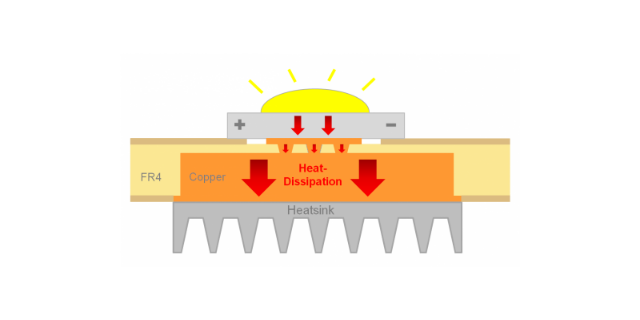The Importance of Thermal Management for LEDs
LED lighting devices experience significant energy loss during AC-DC power conversion, electro-optical conversion (electroluminescence), and wavelength conversion. Unlike conventional technologies, in LEDs, all energy losses in the light emitting process are expelled as heat. This presents a major engineering challenge where more than half of the power input is converted to heat on the LED and circuit board.

LED lighting devices experience significant energy loss during AC-DC power conversion, electro-optical conversion (electroluminescence), and wavelength conversion. Incandescent, fluorescent and metal halide lamps convert waste energy into various combinations of infrared radiation, ultraviolet radiation and heat. Unlike conventional technologies, in LEDs, all energy losses in the light emitting process are expelled as heat. This presents a major engineering challenge where more than half of the power input is converted to heat on the LED and circuit board.
The amount of light emitted by LEDs decreases as the junction temperature (the temperature of the point where the diode connects to the base) increases. Increasing the junction temperature of the LEDs leads to a decrease in voltage. A decrease in voltage also causes a decrease in electrical power. When the two effects are combined, a significant decrease in light output is seen.
The drop in light output is accompanied by a color shift. Every 10 °C increase in junction temperature results in an increase of one nanometer in the dominant wavelength of the LED. As a result, there will be a noticeable color shift towards the higher end of the spectrum when LEDs are operated at high temperature. When the phosphor layer, which makes the LEDs emit white light, is operated above the saturation flux level, color shift occurs.
Operating the LEDs at high temperature for a short time degrades the efficiency and spectral quality of the LEDs. Continuously operating the LEDs above the maximum allowable temperature can cause irreversible damage to the LEDs.
The lifetime of an LED is inversely proportional to its junction temperature. Every 10 °C increase in junction temperature causes a 30 to 50 percent decrease in the useful life of the LED. This permanent reduction in LEDs due to high temperature is known as lumen depreciation. On the other hand, high temperature will accelerate the degradation process of the polymer-based phosphorus layer. Phosphorus degradation and polymer carbonization cause an intolerable color shift in LED lighting.
The ambient temperature has a significant effect on the junction temperature of the LEDs. The cooler the environment, the higher the light output of the LEDs. As the ambient temperature increases, the junction temperature of the LEDs increases and the light output decreases.
Keeping the temperature of the LEDs under control is very important for the optimum performance of LED-based lighting systems. Lighting manufacturers use suitable heat sinks to control the temperature of the LEDs.






